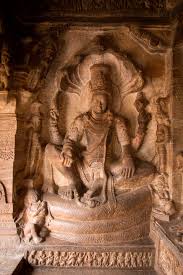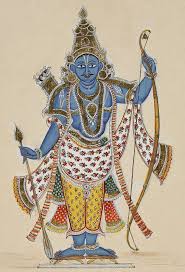Dwadasha stothra 4 : Verse 1
Currently in print as 3rd shloka. According to Hrishikeshateeratharu it is a comprehensive work of 15 shlokas. But currently it is split into 2 different shlokas with each having 8 and 7 shlokas. This seems true because all 15 shlokas are in same chandas. It gives knowledge about God and also teaches the way one should lead life.
The third sthothra is directed to the devotees and his disciples who are exhorted to follow the injunctions of the scriptures with understanding and devotion to attain God’s grace. In the brief length of 9 simple looking shlokas, Acharya Madhva has condensed the Dos and Donts of life in a heart touching and convincing manner. The rejection of Kaamyakarma (worldly desires) leading to renunciation, performance of one’s prescribed duties without desiring the fruits there of (Nishkaama karma), recitation of God’s sacred name and prayers etc are the means to Moksha. But the means themselves are powerless without His grace. The concept of Jaganmithyaathva (unreality of the world) is baseless. All these propositions of Thathvavaada have been covered in this sthothra, leading to the conclusion most cherished of Srimadaachaarya – Vishnu Sarvotthamathva.
kuru bhunkshwa cha karma nijam niyatam haripada vinamradhiya satatam |
harireva paro harireva guru harireva jagatpitrumAtrugatih || 1 ||
This shloka has more stress on laya (rhythm) than on Shruthi.
It is a translated form of Yagniyamantra Upanishad.
kuru bhunkshwa – reap what you sow. Do karma and enjoy its phala
karma nijam niyatam – Do karma which is sahaja to you, which is according to ones swabhava. Do swadharma and not paradharma. Swadharma – karma which automatically happens due to swabhava and prakruthi (Narayana’s icche (volition)). prakritistwaam niyokshyati .Prakrithi also means Maya. Prakruthi also means nature of individual jeeva – varna of jeeva. (Caste/Jathi is for body, varna is for soul)
Swabhava – sattva, rajas, tamas – can be jeeva swabhava or due to external factors .Sattvic swabhava – Shastra shravana, Pooje, Meditation, Sangeetha. Is different for different Jeevas.
Eg: A king in Puranic time, Prachinabrahi was interested in yagnas and performed several yagnas during his reign. Brahi – darbe – halfa grass.
haripada vinamradhiya– do your karma as bhagavantha’s pooje, and do not have karthrutva ahankara.
harireva paro – Hari is supreme
harireva guru – In life we do so many things to obtain 2 kinds of wealth – inner wealth, external wealth. But inner wealth i.e. knowledge can only be obtained by Grace of God.
In anuVykhana Madhwacharyaru says, “JagatGurunam guru manjasaivaa, visheshato mai”
“He is Guru to Brahma and especially to me (Vaayu)”. He is inside every Shishya and every guru and gives them capability to teach and to grasp.
This shloka is also known Hari-ashtakam, since hari shabdha is used several times. Hari is one who removes all types of obstacles.
harireva jagat+pitru+matru+gatiH – He is called Savitha – the one who gives birth to the world
Hari is the Supreme Being, Hari is the father and mother, Hari is the teacher and Hari alone is the final support for the souls. Therefore, do your prescribed duties always with reverence to the feet of the Lord. Accept the fruits there of also with the same submission to His will.
SOME IMMEDIATE COMMENTS ARE NECESSARY HERE:
The Father is the creator as he brings the souls into being as embodied beings. He is also the mother as He maintains their existence in the world. He is the Gathi or final destination for the souls after their sojourn in the world. He is the source of all knowledge as without Him, none of the Indriyas will exist (including the mind). Thus in the four words, Pithru, Maathru, Guru and Gathih, Acharya Madhva has condensed the extremely close relationship between the soul and God. The word Kuru brings the injunction of the Geetha in mind, aptly summed up by Arjuna at the end of 18 chapters – “Nashto mohaha smruthirlabdhaa thvathprasaadaath mayaachyutha, sthithosmi gathasandehah karishye vachanam thava”. God wants us always to perform our duties with detachment with the one and only reason that they are His desire and by doing so, we will please Him. The word Bhunkshwa is also very significant – as it sums up the ones attitude to life – Accept gracefully without demur God’s dispensation. It is that which made Bhima accept all the offences against His person and His family by evil ones led by Duryodhana – Acharya Madhva says in Yamaka Bharatha –
“Kshaathram dharmam svavathaa guruvruthyai keshavaajnayaa cha mam svavathaa, sarvam sehe manasaa bhimenaishaikamaaninaa hemanasaa”
Bhima accepted all the ill treatment of His enemies as required by Kashathra Dharma (his code of conduct as a kshathriya), the desire of Lord Krishna and to follow the directions of his elders like Dharmaraja. This he did when he could have reversed the entire process by applying his superhuman abilities, for which there was none to oppose.



